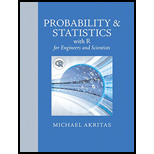Calculation:
Probability:
The formula for probability of event E is,
P(E)=N(E)N
In the formula, N(E) is the number of outcomes for event E and N is the total number of outcomes.
Pairwise independence:
Let E1, E2, E3 be three events, then events are said to be pairwise independent if,
P(E1∩E2)=P(E1)P(E2)P(E1∩E3)=P(E1)P(E3)P(E2∩E3)=P(E2)P(E3)
Also, pairwise independence does not imply P(E1∩E2∩E3)=P(E1)P(E2)P(E3).
The event E1 is defined as sum of the two outcomes is 7 and event E2 is defined as outcome of the first roll is 3 and event E3 is defined as outcome of the second roll is 4.
A die has 6 outcomes {1,2,3,4,5,6}. When a die is rolled twice the outcomes are,
S={(1,1),(1,2),(1,3),(1,4),(1,5),(1,6)(2,1),(2,2),(2,3),(2,4),(2,5),(2,6)(3,1),(3,2),(3,3),(3,4),(3,5),(3,6)(4,1),(4,2),(4,3),(4,4),(4,5),(4,6)(5,1),(5,2),(5,3),(5,4),(5,5),(5,6)(6,1),(6,2),(6,3),(6,4),(6,5),(6,6)}
The total possible outcomes are, N=36.
The favorable outcomes for event E1 are {(1,6),(2,5),(3,4),(4,3),(5,2),(6,1)}. The probability is,
P(E1)=636=0.1667
The favorable outcomes for event E2 are {(3,1),(3,2),(3,3),(3,4),(3,5),(3,6)}. The probability is,
P(E2)=636=0.1667
The favorable outcomes for event E3 are {(1,4),(2,4),(3,4),(4,4),(5,4),(6,4)}. The probability is,
P(E3)=636=0.1667
The favorable outcome for event E1∩E2 is (3,4). The probability is,
P(E1∩E2)=136=0.0278
The favorable outcome for event E1∩E3 is (3,4). The probability is,
P(E1∩E3)=136=0.0278
The favorable outcome for event E2∩E3 is (3,4). The probability is,
P(E2∩E3)=136=0.0278
Independence of events E1 and E2:
P(E1)P(E2)=0.1667×0.1667=0.0278=P(E1∩E2)
Independence of events E1 and E3:
P(E1)P(E3)=0.1667×0.1667=0.0278=P(E1∩E3)
Independence of events E2 and E3:
P(E2)P(E3)=0.1667×0.1667=0.0278=P(E2∩E3)
It can be observed that, the events E1,E2,E3 are pairwise independent.
The favorable outcome for E1∩E2∩E3 is (3,4). The probability is,
P(E1∩E2∩E3)=136=0.0278
Independence of events E1, E2 and E3:
P(E1)P(E2)P(E3)=0.1667×0.1667×0.1667=0.0046≠P(E1∩E2∩E3)
Hence, the pairwise independence does not imply P(E1∩E2∩E3)=P(E1)P(E2)P(E3).

 A First Course in Probability (10th Edition)ProbabilityISBN:9780134753119Author:Sheldon RossPublisher:PEARSON
A First Course in Probability (10th Edition)ProbabilityISBN:9780134753119Author:Sheldon RossPublisher:PEARSON

